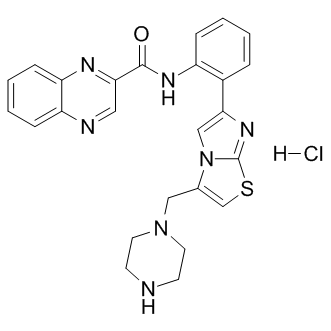| Cas No.: | 1001645-58-4 |
| Chemical Name: | SRT-1720 HCl |
| Synonyms: | SRT-1720 HCl, SRT-1720 hydrochloride; SRT1720; SRT-1720; SRT 1720; CAY10559; CAY-10559; CAY 10559; SIRT-1933; SIRT 1933; SIRT1933. |
| SMILES: | C1CN(CCN1)CC2=CSC3=NC(=CN23)C4=CC=CC=C4NC(=O)C5=NC6=CC=CC=C6N=C5.Cl |
| Formula: | C25H25Cl2N7Os |
| M.Wt: | 542.48 |
| Sotrage: | 2 years -20°C Powder, 2 weeks 4°C in DMSO, 6 months -80°C in DMSO |
| Description: | SRT 1720 Hydrochloride is a selective activator of SIRT1 with an EC1.5 of 0.16 μM, and shows less potent activities on SIRT2 and SIRT3 with EC1.5s of 37 μM and 300 μM, respectively. |
| In Vivo: | SRT1720 (10, 30, 100 mg/kg, p.o.) significantly reduces the hyperinsulinaemia after 4 weeks, partially normalizing elevated insulin levels similar to rosiglitazone treatment. SRT1720 treatment significantly reduces fasting blood glucose to near normal levels in Lepob/ob mice[1]. SRT1720 has ability to protect against the negative effects of diet-induced obesity in mice, and has a connection to metabolic adaptation in fatty acid and oxidative metabolism through downstream targets of SIRT1 such as PGC1α and FOXO1[2]. SRT1720 (50-100 mg/kg, p.o.), during emphysema development attenuates elastase-induced airspace enlargement and lung function impairment as well as reduces arterial oxygen saturation in WT mice[3]. |
| In Vitro: | SRT1720 effectively decreases the acetylation of p53 in cells even in the absence of SIRT1, and this is attributed to inhibition of histone acetyltransferase p300[2]. |

 DC Chemicals' products qualify for U.S. tariff exemptions. We guarantee no price increases due to customs duties and maintain stable supply, continuing to deliver reliable research solutions to our American clients.
DC Chemicals' products qualify for U.S. tariff exemptions. We guarantee no price increases due to customs duties and maintain stable supply, continuing to deliver reliable research solutions to our American clients.





















